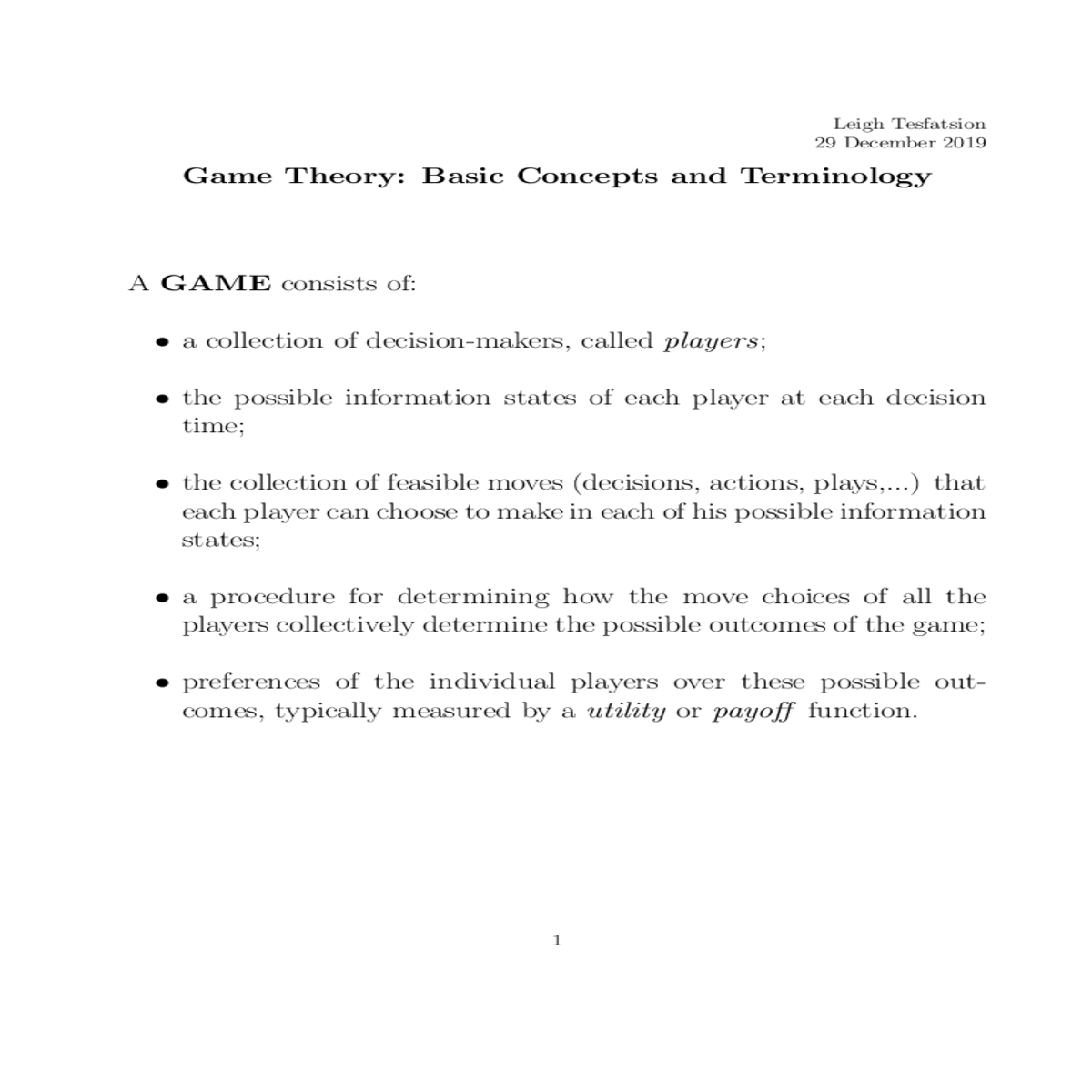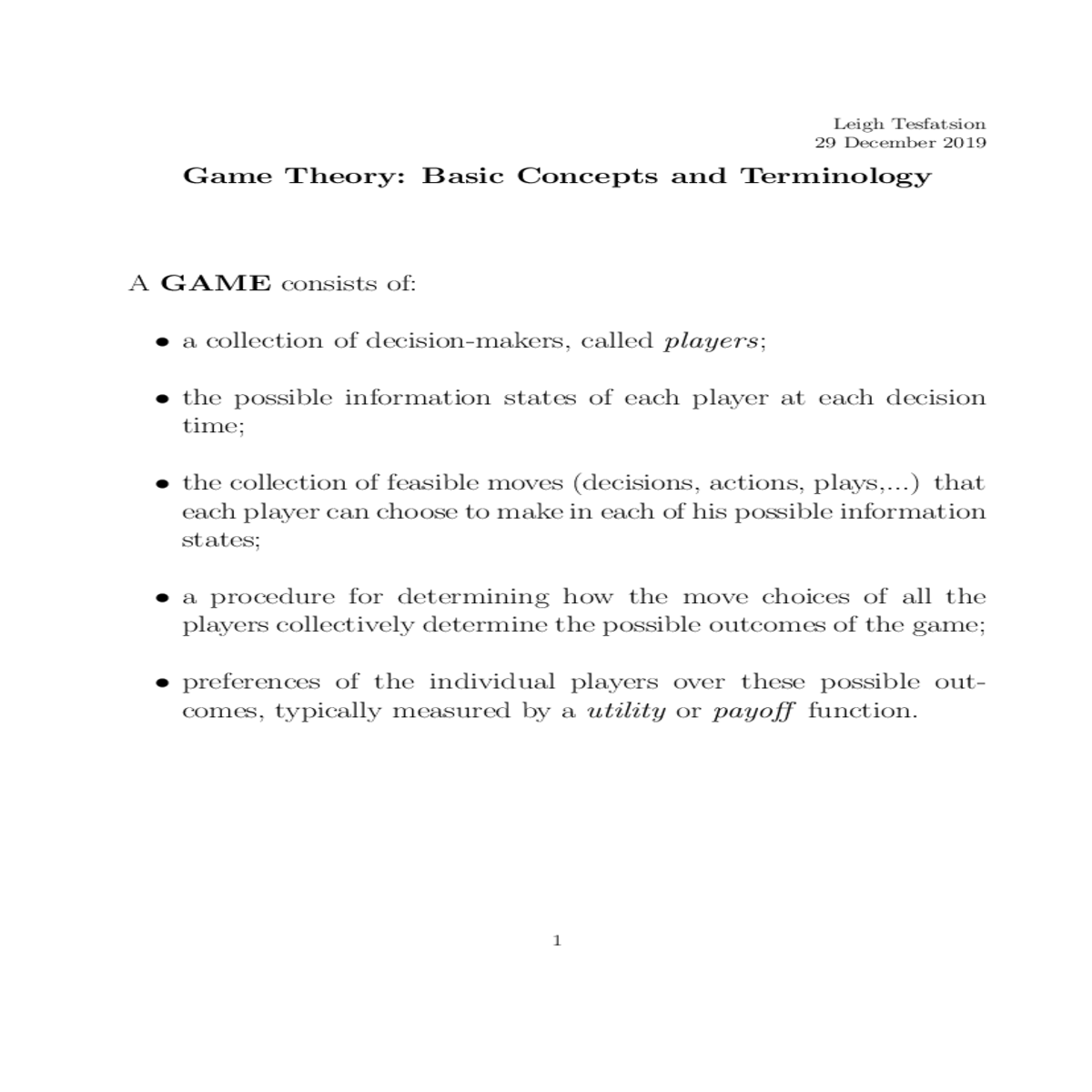The entry the ith row and jth column this table then consists pair values
Leigh Tesfatsion
29 December 2019
time;
• the collection of feasible moves (decisions, actions, plays,...) that
• preferences of the individual players over these possible out-
comes, typically measured by a utility or payoff function.
D = Defect (Shirk) C = Cooperate (Work Hard), (P1,P2) = (Worker Payoff, Employer Payoff)
2
For simplicity, the remainder of these brief notes will develop defi-nitions in terms of pure strategies; the unqualified use of “strategy”will always refer to pure strategy. Extension to mixed strategies is conceptually straightforward.
3
Note: For ONE-stage games, there is only one decision time. Con-sequently, a choice of a strategy based on a current information state is the same as the choice of a move based on this current information state.
4
• If T < TMax, the next iteration T+1 then commences.
• The information states of the players at the beginning of iteration T+1 are typically updated to include at least some information regarding the moves, payoffs, and/or outcomes from the previous iteration T.
More precisely, each of the M rows of the table corresponds to a feasible strategy choice by Player 1, and each of the M columns of the table corresponds to a feasible strategy choice by Player 2. The entry in the ith row and jth column of this M ×M table then consists of a pair of values (P1(i, j), P2(i, j)).
The first value P1(i, j) denotes the payoff received by Player 1 when Player 1 chooses strategy Si and Player 2 chooses strategy Sj, and the second value P2(i, j) denotes the payoff received by Player 2 when Player 1 chooses strategy Si and Player 2 chooses strategy Sj. See the 2-player example depicted on the next page.
Illustrative Modeling of a Work-Site Interaction as a “Prisoner’s Dilemma Game”
D = Defect (Shirk) C = Cooperate (Work Hard), (P1,P2) = (Worker Payoff, Employer Payoff)
A feasible strategy for a player in an N-player game is said to be a dominant strategy for this player if it is this player’s best response to any feasible choice of strategies for the other players.
For example, suppose S∗1is a dominant strategy for player 1 in an N-player game. This means that, no matter what feasible combination of strategies (S2, . . . , SN) players 2 through N might choose to play, player 1 attains the highest feasible (expected) payoff if he chooses to play strategy S∗1.
8
PARETO EFFICIENCY:
QUESTION:
Does the previously depicted worker-employer game have a Pareto efficient strategy combination?
QUESTION:
Does the previously depicted worker-employer game have strategy combinations that are Pareto dominated?
QUESTIONS:
Does the previously depicted worker-employer game have a move combination that exhibits coordination failure?
Example: The pure-strategy Nash equilibrium (Defect,Defect) in a one-stage two-player Prisoner’s Dilemma Game.
In macroeconomics, the focus is on how a group of individuals can become “stuck” in a suboptimal situation because no individual sees any way to improve his/her situation by unilateral actions. Im-provements that hurt no one and help at least someone can only come about through strategy changes undertaken simultaneously by a coalition of agents as a result of some kind of newly introduced strategy coordination mechanism (institution).
• Some researchers require the Pareto-dominating strategy config-uration to itself be a Nash equilibrium. That is, the focus is on a sequence of two or more Pareto-ranked Nash equilibria, where each successive Nash equilibrium Pareto dominates all earlier ones. Example: The Pareto-ranked Nash equilibria along the diagonal of the payoff matrix for a Stag-Hunt Game.
• Some researchers say that a game can result in “coordination fail-ure” only if it is possible for players to end up in some kind of dis-equilibrium strategy configuration. Example: The possibility of off-diagonal outcomes in the Battle of the Sexes Game when each player is uncertain about what the other player will do (and this uncertainty is common knowledge).
Leigh Tesfatsion
Department of Economics
Iowa State University, Ames, IA 29 December 2019
1
Five Illustrative One-Stage Two-Player Games ❑Symmetric Games
▪ Type 1: Prisoner’s Dilemma
▪ Type 2: Dead Lock
▪ Type 3: Chicken
▪ Type 4: Stag Hunt❑Non-Symmetric Game
▪ Battle of the Sexes
3
| C | C |
|
|---|---|---|
| (R, R) |
|
|
| D | (T, S) |
Type 1: PD Game … Continued T > R > P > S ( [T+S]/2 < R )
| C | C | |
|---|---|---|
| (R=3, R=3) | ||
| D | (T=5, S=0) |
PURE-STRATEGY ANALYSIS FOR ONE-STAGE GAME:
(D,D) is the unique pure-strategy Nash equilibrium, and D is a dominant pure-strategy choice for each player. However, (C,C) Pareto-dominates (D,D). The three choice pairs (C,C), (C,D), and (D,C) are all Pareto efficient, but (C,C) is the most socially efficient
| C | C | D |
|---|---|---|
| (R=1, R=1) | ||
| D | (T=3, S=0) |
|
7





